Feagh McHugh O’Byrne
Published in Early Modern History (1500–1700), Features, Gaelic Ireland, Issue 1 (Spring 2000), Volume 8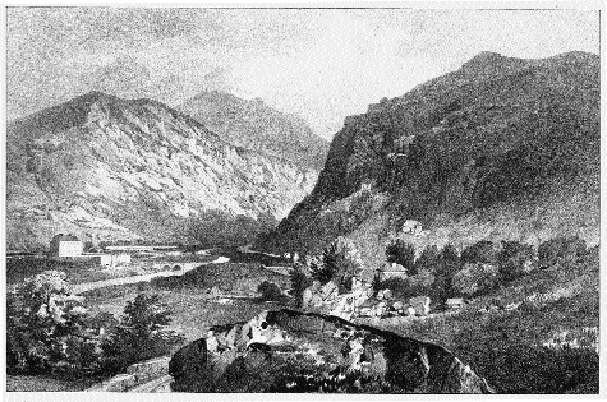
Nineteenth-century lithograph of Glenmalure, County Wicklow. (G. Rowe)
Feagh M’Hugh of the mountain—
Feagh M’Hugh of the glen—
Who has not heard of the
Glenmalur Chief,
And the feats of his hard-riding men?
When these lines by Thomas D’Arcy McGee were published in The Nation in 1854, one wonders if indeed any of its readers had heard much about the feats of the Glenmalure chieftain. For nothing of any substance had been written about Feagh McHugh before then, and it was not until 1860, when a study of the State Papers of the late 1500s about Feagh was commissioned by the historian Fr. C. P. Meehan and published over three issues of Duffy’s Hibernian Magazine, that anything meaningful about his role in history became available in print. Another lapse into obscurity lasted until 1890 when a hagiographic work about the Wicklow clans, by Fr P.L. O’Toole, was published. In reacting to what he perceived as another nauseous attempt by such Catholic writers to canonise Feagh, P.H. Hore, in the final one of his six-volume History of the Town and County of Wexford (1911) asserted that Feagh ‘was a contemptible character, full of meanness, hypocrisy and fraud’. Even Feagh’s wife, Rose O’Toole, did not escape Hore’s vitriol, commenting that she ‘seems to have been also of the same contemptible and treacherous character’. A more balanced study of the calendared papers, this time by the doyen of Wicklow historians, Liam Price, was published in the Kildare Archaeological Society’s journal in 1932. Price adverted to Lord Deputy Russell’s assertion to the Privy Council in London that Feagh ‘is of far greater ability than the Earl [Hugh O’Neill, Earl of Tyrone]’. On the other hand Cyril Falls in Elizabeth’s Irish Wars (1950) dismissed Feagh as ‘by comparison with Tyrone, a simple-minded savage’. Recent scholarship, prompted by the 1997 quatercentennial of Feagh’s death, has facilitated a reappraisal of the life of this Leinster chieftain revealing him to be one of the most underrated figures in Irish history.
The O’Byrnes of Ranelagh
Feagh was born, probably in the early 1540s, into the house of the chiefs of Gabhal Raghnaill. These were a semi-autonomous, junior sept of the O’Byrnes that had emerged in the early thirteenth century, deriving their name from Raghnaill O’Broin who, according to the ancient but possibly dubious genealogies, was tenth in line of descent from Bran mac Maolmordha, an early eleventh-century king of Leinster from whom the name O’Byrne itself is reputedly derived. Their territory, centred at Ballinacor in Glenmalure, loosely ranged from Glendalough southwards to Shillelagh on the Wexford border and westwards to the Carlow border, occupying about 150,000 acres. In time it became known as Ranelagh and variants of that name, and when Sir Roger Jones, the grantee of a considerable portion of these lands by Charles I, was raised to the peerage in 1628 he adopted this name as his title. Through Viscount Ranelagh’s successors the name has entered the toponymies of such disparate cities as Dublin, London and Paris. When his father, Hugh McShane O’Byrne, died in 1579 Feagh succeeded him as chief. By that time, under his father’s forceful leadership, the Gabhal Raghnaill had virtually eclipsed
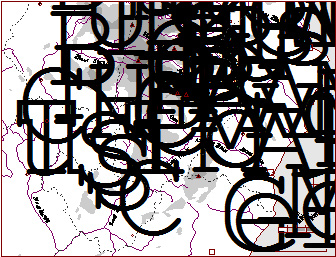
(Matthew Stout)
the Crioch Branach, the senior branch, as the dominant one of the O’Byrnes and it was the activities of the sept of ‘the Ranelaghe’ on the southern side of the Pale that the Dublin administration worried most about.
Networking
Feagh’s first wife was Sadhbh, daughter of Donall McCahir, chief of the sept of Kavanaghs of Garryhill. Both Feagh and Sadhbh were great-great grandchildren of Murrough Ballach Kavanagh, a late fifteenth-century king of Leinster. Sadhbh is thought to have been the mother of all Feagh’s legitimate children. The marriage did not endure and at some time before 1573, Feagh married Rose O’Toole. She was a daughter of Feagh O’Toole of the Castlekevin branch of that name and was probably a teenage bride. Two of her sisters married two of Feagh’s sons by Sadhbh Kavanagh.
Alliances by Feagh’s sisters with members of Gaelic Leinster’s chieftainry are also notable. His sister Isabel married first, Brian McCahir Kavanagh of St Mullins, County Carlow, chief of his sept, and after his death in 1578 she married Phelim O’Toole of the Powerscourt branch. Feagh’s sister Margaret Maol was married to Rory Oge O’More, the Laois chieftain. She, and two of their sons, were amongst those slaughtered in 1577 in an assault on Rory Oge’s dwelling by Robert Harpool, constable of Carlow Castle. Another of Feagh’s sisters, unnamed, was married to Cahir Duff Kavanagh of Clonmullen, a great grandson of Art Buidhe, a king of Leinster who died in 1517. Cahir Duff was a near cousin of Donall Spaineach Kavanagh, Feagh’s close confederate-in-arms, who married Eleanor, a daughter of Brian McCahir Kavanagh of St Mullins, Feagh’s brother-in-law. After Cahir Duff’s death, this sister of Feagh married in 1582 Teige McGilpatrick, chieftain of the O’Conors of Offaly. This extensive nexus with the leading Gaelic families of south Leinster was to be a significant factor in the career of Feagh McHugh.
Insubordinate acts
Long before being chosen by his sept to assume his father’s mantle, Feagh was virtually de facto chieftain. He is first noted in an unfavourable light in government records in 1563 when two Wexford-based garrison captains were captured by him and his father, probably with the intention of earning a ransom. Insubordinate acts continued apace throughout the following decade and in 1571 he began to link up with Rory Oge O’More, leader of the dispossessed Laois clan and his future brother-in-law, no doubt feeling that government plantation policy in that region was a foretaste of its ambition for the remainder of Gaelic Leinster. An incident occurred in April 1572 which directly incurred the queen’s wrath. He was believed by the government to have been involved along with another brother-in-law, Brian McCahir Kavanagh of St Mullins, in the murder of an extremely influential landowner in south Wexford, Robert Browne of Mulrankin. Land ownership and tenure was the background to the quarrel. The outrage resulted in a personal instruction from the queen to the Lord Deputy to have the perpetrators brought to justice. This provided an excuse for Francis Agarde and Nicholas White, the seneschals governing the Kavanagh and O’Byrne territories in Wexford and Wicklow respectively, to pursue the extirpation of these Gaelic chiefly families in a manner reminiscent of latter-day acts of ethnic cleansing and genocide in the Balkans or Africa. Armed with the authority of martial law commissions, the seneschals could do what they willed with impunity. White was all the more determined because Browne’s wife was his daughter. In the event, Feagh proved more difficult to crack than they had bargained for. In August 1572 he invaded Wexford with 300-400 followers and after burning several villages in the south of the county and defeating the seneschal’s attempts to intercept him, he returned to the virtually impenetrable haven of Glenmalure with considerable plunder. Due to the unsettled state of the country as a whole at this time, Lord Deputy Fitzwilliam was reluctant to support White in an all-out campaign against Feagh, and the eventual upshot was that Feagh was given a pardon in February 1573 for a fine of twenty marks.
Masterson’s reign of terror
Soon afterwards White was replaced as seneschal by Thomas Masterson, a garrison commander who had arrived in Ireland in the 1540s. He believed in using the full rigour of martial law to terrorise the populace into submission, and decried peace treaties and grants of pardon. Feagh determined on showing Masterson he would not be intimidated and frequently led raids on Masterson’s lands around Ferns. Such raids would be met with counter attacks on the Gabhal Raghnaill by Masterson and the seneschals of Carlow and Wicklow and many atrocities were committed. Matters came to a head in April 1580 when a confrontation occurred between Seneschal Masterson and the Art Boy Kavanaghs which resulted in the summary execution of a considerable number of the clansmen by Masterson. Many of these were connections of Feagh and he, on hearing of this savagery, determined on revenge. It was Masterson’s extreme behaviour more than anything else that propelled Feagh into outright rebellion.
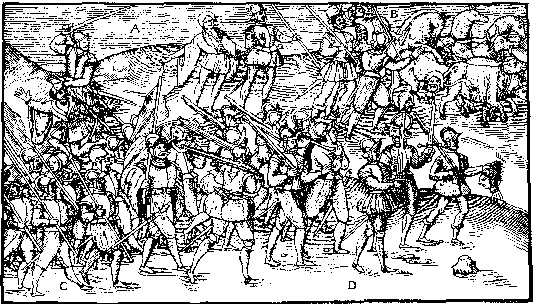
This woodcut from John Derrick’s Image of Irelande (1581) shows the English army returning triumphant from battle carrying the severed heads of the defeated Irish. The one on the extreme right, held by the hair, is reputedly Feagh’s sister, Margaret Maol O’Byrne, wife of Rory Oge O’More. One can imagine Feagh’s own head being carried back by Lord Deputy Russell’s men in similar fashion.
However this was also the age of ‘faith and fatherland’. Feagh, who had recently been requested by the Earl of Desmond ‘to take part with us, according as you are bound by conscience and nature, to defend your country’, now found himself in a hitherto unlikely partnership with the Counter Reformation Catholic, James Eustace, Viscount Baltinglass. While this revolt was understood to be under the joint leadership of Baltinglass and Feagh, it was clearly the latter who was the principal leader even though Baltinglass was the designated commander. Once the revolt got underway Feagh began to organise under his personal command all the Gaelic lordships in Leinster, persuading the prominent leaders to swear acceptance of his authority in all matters and even sought to appoint a new ‘king of Leinster’ from amongst his Kavanagh kinsmen.
‘The great overthrow’
This development scared the authorities in Dublin more than they had ever been by Feagh, prompting the new Lord Deputy, Arthur, the fourteenth Lord Grey de Wilton, within days of his arrival in Ireland in August 1580, to embark precipitately on a mission to sort out this menace on the borders of the Pale once and for all. The Lord Deputy’s army and the rebel forces met in Glenmalure on 20 August. The outcome for Grey was a humiliating rout which was long remembered and recalled. One of his officers was William Russell who, revisiting Glenmalure in February 1595, now as Lord Deputy, was painfully reminded of ‘the Glens, where my Lord Grey took the great overthrow’ on the side of a ‘monstrous steep mountain’, an apt description for the area into which the inexperienced Grey had been lured. Grey’s defeat at the hands of Feagh and his allies had a bloody sequel. On recovering from his punishing encounter in Wicklow Grey set out for Kerry where he transferred his aggression onto the Desmond rebels. Most infamously, he surrounded Dún an Ór at Smerwick, bombarded it into submission and then massacred the surrendering garrison of Italian and Spanish soldiers.
Sporadic encounters between Feagh and Grey’s forces occurred during the next few years but for the most part both sides seemed content not to engage in full-scale hostilities, with Feagh giving hostages to the government for his good behaviour. Lord Grey was succeeded as deputy by Sir John Perrot in 1584, and he in turn by Sir William Fitzwilliam in 1588. Occasional confrontations, precipitated for one reason or another, followed by temporising arrangements, was the pattern of relations between Feagh and Dublin Castle during their administrations. But it could not last: peaceful co-existence of a virtually independent Gaelic principality on the borders of the Pale was incompatible with plans to subordinate the whole country to the queen’s rule.
Escape of Red Hugh
The Battle of the Armada was fought in the summer of 1588 and though Feagh renewed his submission at the time to Fitzwilliam, he continued to be regarded with deep suspicion because it was felt that he was looking for Spanish assistance. Constant surveillance was maintained despite Feagh’s best efforts to pretend he was a dutiful subject. In January 1592, Red Hugh O’Donnell, on his second attempt, successfully escaped from custody in Dublin Castle where he had been detained for over four years. Feagh gave refuge to Red Hugh in Glenmalure until Art Braddagh O’Hagan, the seneschal of Tyrone, arrived to escort him home to Ulster. This successful escape, which should have served to confirm fears of a major conspiracy amongst the Gaelic Irish, was played down by Fitzwilliam’s embarrassed and corrupt administration
Like his northern allies, Feagh at first took action against the state through proxies. The revolt in Leinster broke out in March 1594 when a party which included Walter Reagh Fitzgerald and three of Feagh’s sons attacked and set fire to Ardree Castle near Athy, the seat of Sir Piers Fitzjames Fitzgerald, an old foe. The occupants, including Sir Piers, his wife and two of her sisters and their daughter, were wilfully burnt to death. Despite Feagh’s protestations to Lord Burghley of his abhorrence of ‘the late most wicked and detestable’ action and his promise ‘to discharge his duty as a subject against any foreign power’, his insincerity was clear to the government.
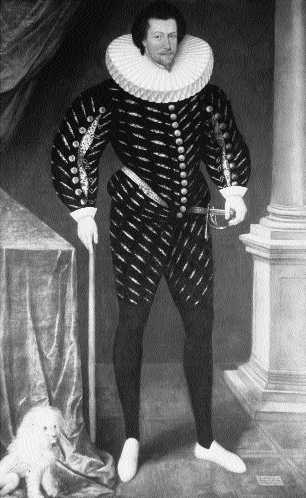
Lord Deputy Sir William Russell-a high priority was the disposal of ‘the old cankered traitor Feagh M’Hugh…for many years the gall of Leinster and principal disturber thereof’. (Woburn Abbey)
It was in receipt of intelligence reports that he was receiving visitors from Spain and that he had set all his axemen and smiths to making pikes, while in Ulster his ally, the Earl of Tyrone, was busy mustering men and ‘preparing to put them in a readiness’.
Russell’s hunting party
Sir William Russell replaced Fitzwilliam as Lord Deputy in August 1594. A high priority was to dispose of the problem of ‘The old cankered traitor Feagh M’Hugh…for many years the gall of Leinster and principal disturber thereof’. The elimination of Feagh and the cleansing of the countryside of all ‘his beggarly rabble of these mountains’ was to preoccupy Russell for the remainder of his three-year tenure of office. It is unlikely that he viewed the task as a pushover. He had the experience of serving under Lord Grey in the Glenmalure debacle in August 1580. And again in April 1581 he had been routed by a force quickly mustered by Feagh when he and Sir William Stanley conducted a surprise raid into ‘Coalrannell’ (Gabhal Raghnaill), though they did succeed in burning down ‘his town and house called Ballinacor’. In January 1595, having prior knowledge that Feagh, his wife and all his sons, along with Walter Reagh, were in residence in Ballinacor, the Lord Deputy, affecting that he was going on a hunting expedition, set out from Dublin to make a surprise attack once again on Feagh. The outcome was the same as it had been fourteen years previously. Possession was taken of Feagh’s house at Ballinacor. The occupants—save for a breast injury to Rose—escaped virtually unscathed into the glen and found temporary safety in the recesses of Dromkitt three-quarters of a mile distant. Leaving a garrison in charge at Ballinacor, the deputy returned to Dublin to make preparations for a return expedition ‘for the unkennelling of the wolf out of his den of Dromkitt’.
On 1 February 1595, accompanied by a formidable array of knights, captains and ‘many other gentlemen’, Russell set out once again for Ballinacor. The expedition lasted until 24 February but though they bagged many heads, once again the chief prize eluded them. On 11 April, accompanied by most of the Irish Council, Russell embarked on a further expedition to Wicklow, focused on the Shillelagh district. The expedition lasted until 15 May and their prize catch was Feagh’s wife Rose and her sister. On 27 May Rose was sentenced to be burned, though in the event it was not carried out, presumably because she was a more valuable instrument against Feagh if kept alive.
A report by Captain Chichester relating army activity in the district during the week after Russell’s return, gives a picture of the barbarity of the times and the wanton slaughter committed on ordinary people. In Cosha and Shillelagh, he reported that they had burnt sixteen towns, took 160 head of cattle, adding as if of little significance, ‘besides other killing’. Moving to Aughavannagh, ‘we killed two of Feagh’s foster brothers…two of their sisters, four or five kerne and as many others as were in five cabins’. Proceeding towards Glenmalure, their spies reported that they could be guaranteed a prize of 500 head of livestock, or as an alternative, some killing. It was the latter option that
Captain Hungerford and Lieutenant Parker rather chose; at the break of the day they entered [Glenmalure] and had the killing of divers; what they were, I know not; they brought away 5 swords with 6 gallowglass axes; they slew many churls, women and children.
It was this report that prompted John Anthony Froude to remark in his History of England, ‘in justice to the English soldiers, however, it must be said that it was no fault of theirs if any Irish child of that generation was allowed to live to manhood’.
‘Old and sickly’
Inevitably, continual government pressure had its effect on Feagh. The precarious situation of his wife Rose, to whom all appearances suggest he was devoted, distressed him and in June he sued for peace, offering to surrender his eldest son Turlough. Russell was at this time more concerned with developments in Ulster and agreed, leaving it to Sir Henry Harrington, seneschal in Wicklow, to fix the conditions. Feagh, Harrington felt, was now ‘old and sickly and not to be reckoned with’ if Turlough were out of the way. The Lord Deputy and Council agreed, noting that Feagh’s body was ‘unwieldy and spent with years’. In November 1595 Feagh came to Dublin and formally submitted to the Council whereupon he was granted safe-conduct for three months, renewable from time to time. It would appear that Rose was released at this time despite the fact that Russell continued to have reservations about Feagh’s sincerity while he for his part had little cause to place any trust in the government and continued to maintain close links with O’Neill and his allies in Ulster.
On 9 September 1596 a convoy of munitions proceeding to Ballinacor was attacked and defeated outside Rathdrum by a party led by Redmond, Feagh’s son. Next day the fort at Ballinacor was overrun and Captain Tucher, the garrison commander, taken prisoner. A sergeant was released to inform the Lord Deputy that the captain would only be redeemed by cancelling the bonds taken for Feagh’s wife. Given Feagh’s vulnerability at the time, the action appears rash though studies have not yet revealed what miscalculation or what misinformation prompted it. In response, Russell set out on 18 September, once again for Rathdrum. On arrival two days later he began fortifying the church and establishing a garrison there. Except for eight days when he returned to Dublin, Russell spent from then until 29 October making forays around the countryside but yet again failed to track down his quarry.
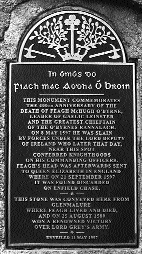
Monument to Feagh McHugh O’Byrne, Parnell National Memorial Park, Rathdrum,
On 20 February 1597 he returned to the chase, scouring the country from Carlow to Hacketstown and over the mountains down into Glenmalure and back to Carlow, returning to Dublin via Naas on 15 March with little to show for his pains.
Russell gets his man
On 7 May 1597, as his diarist records, ‘My lord took his last journey towards the Glens in prosecution of Feagh McHugh, and rode to Rathdrum’. Companies stationed at Tullow and Rathdrum had already been appointed to be in readiness. A traitor in Feagh’s camp had given the information as to where the aged chief lay. Approaching from different directions, the viceregal forces entered Glenmalure about two o’clock on Sunday morning, 8 May 1597, when, in the words of the diarist,
it pleased God to deliver him into our hands, being…run out of breath and forced to take a cave where one Milborne, sergeant to Captain Lee, first lighted on him, and the fury of the soldiers was so great as he could not be brought away alive; thereupon the said sergeant cut off Feagh’s head with his own sword and presented the head to my Lord, which with his carcass was brought to Dublin.
On returning to Rathdrum, the exultant Lord Deputy ‘there before the fort knighted Sir Callistenes Brooke, Sir Thomas Maria Wingfield and Sir Richard Trevor’.
A present for the queen
After Feagh’s head had been impaled at Dublin Castle for a while, it was sent to London to be exhibited to the queen. She, however, signified ‘her high displeasure at such a present sent with so much of vain parade’. As to the celebrations before the fort at Rathdrum, Secretary of State Robert Cecil wrote that ‘Her majesty is much troubled with the late knights that were made, and not content that the head of such a base Robin Hood is brought so solemnly into England’.
Some months later it was reported that one John Lane, having brought Feagh’s head into England, sought the head money from Mr Secretary who, since the reward had already been paid in Ireland, told him he might do what he liked with it. Lane gave it to his servant to bury in Enfield Chase, who instead put it on a tree where it was found on 21 September 1597 by two boys looking for their cattle. So ended in this ignominious manner the life of the greatest Wicklow chieftain.
Conor O’Brien is a retired pharmaceutical industry executive.
Further reading:
C. O’Brien (ed.), Feagh McHugh O’Byrne, the Wicklow Firebrand, Journal of the Rathdrum Historical Society (1998).
















